During the winter dormant season, there are a significant number of potential pests of ornamentals that require monitoring. Pest populations ignored during the off season is a missed opportunity to evaluate future problems. These potential concerns can be especially pronounced on evergreen shrubs and conifers. Therefore, this winter do not make the mistake of thinking that landscape problems can be forgotten about until next spring. A little vigilance now can go a long way toward recording & possibly reducing future problems. The following is a review of some of the major pest problems that require monitoring and possible management actions during the next few months.

Winter pest monitoring can still be achieved during the off-season. (Photo Credit: Steven K. Rettke, Rutgers Coop. Ext.)
Defoliators: Gypsy Moths, Eastern Tent Caterpillars and Fall Cankerworms all have overwintering egg masses on twigs, branches, and/or trunks. Learn the appearance of these egg masses so they can be mechanically removed or pruned out. If the egg masses are too numerous or out of reach, then indicate in your records that treatments will be required next spring.
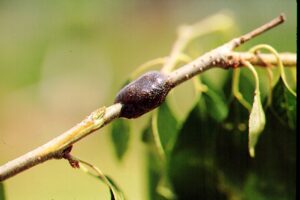
Eastern Tent Caterpillar egg mass is found at end of outer branch twigs. (Photo Credit: Steven K. Rettke, Rutgers Coop. Ext.)

Cankerworm egg mass is a single layer thick & can be controlled with dormant oils. (Photo Credit: Steven K. Rettke, Rutgers Coop. Ext.)
Mimosa Webworms overwinter as white colored pupae within bark cracks & crevices of the trunk and can found on honeylocust & mimosa trees. Typically close inspection is required for detection. With extreme infestations they will be obvious. The adults of the first generation will emerge during the later weeks of spring & lay eggs within the leaves. Look for the first signs of webbing on leaves from caterpillars beginning in June.
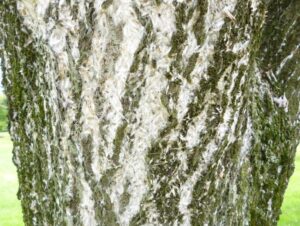
Extreme populations of Mimosa Webworm pupae requires no close monitoring. (Photo Credit: Steven K. Rettke, Rutgers Coop. Ext.)

Overwintering Mimosa Webworm pupae hidden beneath bark flaps. (Photo Credit: Steven K. Rettke, Rutgers Coop. Ext.)
Spider Mites: Spruce mites and Southern Red mites are the common cool season spider mite pests that increase their activity during the fall months. Their peak populations occur during October and November. Generally, by December, most overwintering eggs have been laid on leaves, needles, and twigs. With magnification, the clear or reddish-orange bubble shaped eggs can be observed. Horticultural oils can be highly effective at suppressing both eggs and active adults.
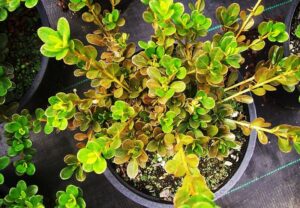
Azalea shrub with stippling symptoms from Southern Red Spider Mites. (Photo Credit: Steven K. Rettke, Rutgers Coop. Ext.)
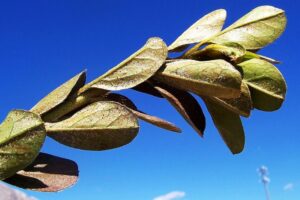
Southern Red Spider Mites overwinter as bright red eggs. (Photo Credit: Steven K. Rettke, Rutgers Coop. Ext.)
Wood Borers: Dogwood, Lilac, Ash and Rhododendron borers are the larvae of clearwing moths and produce pencil-sized holes in trunks or branches. Fresh borer holes on the bark with flight colored sawdust (frass) indicate active larvae. These can be treated with entomopathogenic nematodes (use the H.b. nematode) if the weather is not below freezing. Infested plant material can also be pruned out if smaller branches are infested. Residual chemical sprays on the bark are of no value at this time of year.
Flat headed borers (e.g., Bronze Birch & Emerald Ash borers) overwinter as larvae under the bark. The “D” shaped exit holes that were created during the summer. Observing the number of exit holes will give an indication of the infested tree’s chances for survival during the next season.
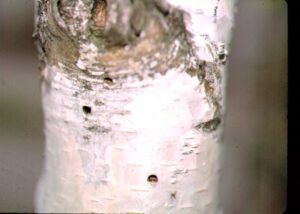
Bronze Birch Borer exit holes at main stem typically signals the end is near for the tree. (Photo Credit: Steven K. Rettke, Rutgers Coop. Ext.)

Lilac Borer exit holes indicate these stems need to be pruned out. (Photo Credit: Deborah Smith-Fiola, former Rutgers Ag. Agent)
Bagworms: Obviously, any type of spray applied in the winter would be a waste of time and material. Overwintering eggs are contained within the dead female bags. Most of the bags containing eggs are located on the upper portions of infested trees or shrubs. With this higher elevation, it is theorized that a certain percentage of a recently hatched population can more effectively be transported by the wind to new hosts. Remove individual bags by hand when populations are low, and the upper portions of the plant can be reached. Otherwise, indicate in your records that sprays may be required during the late spring or early summer when the young larvae hatch and begin feeding.
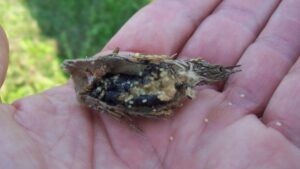
Bagworm sacks can contain a few hundred eggs. Remove sacks before they hatch in June. (Photo Credit: Steven K. Rettke, Rutgers Coop. Ext.)
Leafminers: Arborvitae, Boxwood and Holly leafminers all overwinter as live larvae within foliage tissue. Pale colored lines or blotches indicate the leafminer presence in evergreen leaves. Inspect mines for live larvae and physically remove infested leaves when limited populations are present on small plants. Heavily infested plants can be noted in your records and scheduled for treatment next season. If soils are not frozen & soil moisture is adequate, then a soil systemic (e.g., Merit) can be applied during the early spring.
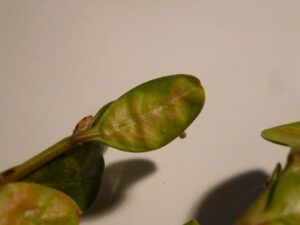
Boxwood Leafminer symptoms are often obvious during the winter months. (Photo Credit: Steven K. Rettke, Rutgers Coop. Ext.)

Overwintering active Boxwood Leafminer larvae exposed. (Photo Credit: Steven K. Rettke, Rutgers Coop. Ext.)
Adelgids: The Eastern Spruce Gall, Cooley Spruce Gall and Hemlock Woolly Adelgids all overwinter as immature females and are vulnerable to control treatments during the late months of the year. The product of choice with smaller plants is the use of horticultural oils or soaps when good coverage can be achieved. Remember to target sprays onto only the most recent growth or terminal twigs and buds where the adelgids are located. Heavy populations of HWA on large hemlocks are best controlled with an imidacloprid (Merit) treatment. With larger trees, the systemic treatments will require at least 2 months to translocate throughout the upper canopy.
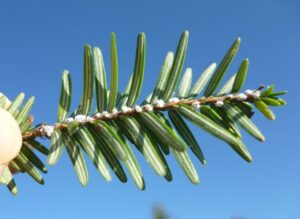
Hemlock Woolly Adelgids overwinter as immature females. During early spring they begin laying eggs within the woolly masses. (Photo Credit: Steven K. Rettke, Rutgers Coop. Ext.)
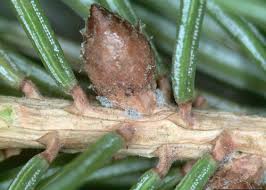
Spruce Gall Adelgids overwinter as stem mothers at base of outer branch buds. They can be controlled with targeted soap or oil sprays. (Photo Credit: OMAFRA.gov.ontario)
Soft Scales: Tuliptree , Magnolia, Fletcher, Calico, Lecanium, Cottony Maple and Cottony Camellia are all examples of soft scales that overwinter as nymphs on twigs or branches of mostly deciduous trees and shrubs. Before leaves drop in the fall, many scale species crawlers move back from the leaves to the bark where they overwinter as 2nd instar nymphs. Late winter dormant oils are particularly effective against the soft scale nymphs.
To help discover the presence of soft scale nymphs during winter monitoring, look for old black sooty mold on needles, twigs or branches that grew on exuded honeydew last year. Close inspection is often required to detect the overwintering translucent nymphs. The Magnolia & Tuliptree nymphs will be black in color. Avoid broad-spectrum cover sprays during the growing season to conserve beneficials. Predators and parasitoids can often effectively control soft scale populations when not destroyed by unnecessary sprays.
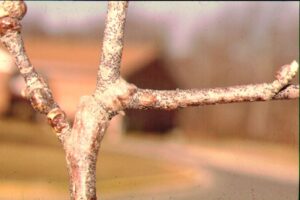
Black colored Tuliptree Scale 2nd instar nymphs overwinter on branches. (Photo Credit: Steven K. Rettke, Rutgers Coop. Ext.)
Armored Scales: Euonymus, Elongate Hemlock, Pine Needle, Juniper, White Prunicola, Pine Oystershell, Obscure and Oystershell are all examples of armored scales that can be monitored during the off-season months. Look for the white or gray colored scale covers of the overwintering adult females on twigs, branches, or trunks. Dormant oil control sprays can be helpful but are not as effective on armored as compared to soft scales. When infestations are extremely high, the scale populations may be lightly brushed off the trunk and branches, or simply pruned out.
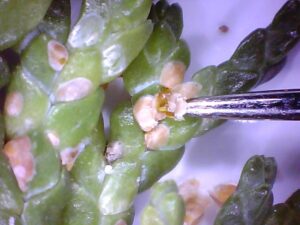
Juniper Scales being tested for viability. Body fluids emerging from this pierced scale. (Photo Credit: Steven K. Rettke, Rutgers Coop. Ext.)
Lace Bugs: Species of lace bugs with evergreen hosts will overwinter in the egg stage (e.g., Azalea, Rhododendron, Andromeda). Attempting to control these lace bug eggs with dormant oils will not be successful. The use of pesticide sprays will have to wait until they hatch in the spring. With deciduous hosts, on the other hand, lace bug species overwinter as adults in protected areas (e.g., Hawthorn, Oak). Attempting to control overwintering adults with oils would also probably be unsuccessful, and therefore is not recommended. Wait and monitor for egg hatch next spring and apply oil/soap (if good coverage can be achieved) or Orthene at that time. Imidacloprid (Merit) treatments as a soil drench offers long-term control.
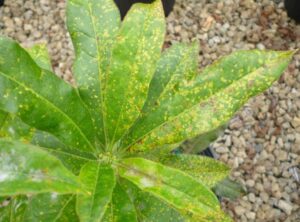
Rhododendron Lace Bug stippling symptoms. Overwintering eggs are inserted into tissue under leaves & cannot be controlled with dormant oils. (Photo Credit: Steven K. Rettke, Rutgers Coop. Ext.)
Halloween Lady Beetles: The Harmonia beetle can become a major nuisance in homes during the winter months. These lady beetles are often orange in color, with or without many spots. In the fall, they tend to congregate in huge numbers on white colored homes with a southern exposure. If they can find small cracks and openings they then move inside to overwinter. Massive populations have been known to accumulate in attics & crawl spaces. Since this is a beneficial insect, sprays are not recommended. A light trap developed by USDA scientists has been developed for inside of structures. After trapping they can then be released outdoors. Information is available via H&T Alternative Controls (877/967-6777). This number may no longer be current.

